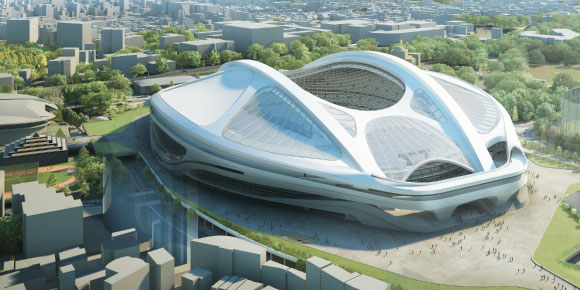
I’ve got nothing but love for Tokyo, and I’ve spent a good chunk of my adult life working and playing in Japan’s city of cities. Still, I remember having mixed emotions when it was announced as the site of the 2020 Olympics.
Like everyone at RocketNews24, I truly believe Japan is an awesome place, and I’m happy whenever something happens that gets people to take a peek at what’s going on here. But I was worried that in the run-up to the 2020 Olympics, Japan would embark on a glut of overly extravagant construction projects, building needlessly expensive stadiums that would fall into disuse or disrepair soon after the Games ended, as has happened in so many other host cities.
That certainly seemed to be what was happening with Tokyo’s New National Stadium. Every few months came a new report that cost estimates had been revised up yet again, and the expected price tag recently soared to 252 billion yen (US$2.02 billion). Finally, though, the Tokyo Olympics organizers have said enough is enough, and they’ve decided to toss out the existing design completely and start over from scratch.
Originally, the stadium wasn’t expected to be anywhere near so costly. Even before Tokyo was selected for the 2020 Olympics, there were plans to tear down the 54,000-seat National Stadium in Shinjuku Ward, the centerpiece the 1964 Tokyo Olympics, and build a new stadium on the same site. In 2012, a design from award-winning Iraqi-British architect Zaha Hadid was chosen.
The project started getting even more attention after the I.O.C. awarded the 2020 Games to Tokyo in September of 2013. But just three months later, Hadid was asked to revise her design in light of the high projected cost of achieving her original vision.
The revised plan still imagined an 80,000-seat stadium, though, which seems particularly ambitious in a city where the largest regularly held sports events are professional baseball games. Some also questioned the need for a planned retractable roof, especially once the estimated total cost ballooned to over 250 billion yen. Not only would that have been three times what London spent on its stadium for the 2012 Olympics, it would have been nearly double the amount Tokyo organizers originally believed Hadid’s revised design could be built for.
Tokyo’s Olympic committee and Hadid don’t agree on how costs mushroomed to such a startling extent. The architect’s design firm, London-based Zaha Hadid Architects, blames increases in Tokyo construction costs, as well as deadline difficulties. The Tokyo Olympic organizers, while admitting that the rising cost of building in Tokyo may have contributed to one-third of the increased estimated costs, point to design elements, such as a pair of difficult-to-build curved support arches, as the reason for some roughly 74 billion yen in additional funds that would have been required.
Hadid has also insinuated that resentment towards a foreigner’s design being selected contributed to the criticism her plan faced, calling out prominent Japanese architects who expressed their displeasure for it ,while working overseas themselves, “hypocrites.”
But more important than debatable accusations of nationalist pride is the fact that, for the most part, fiscal conservatism is seen as a virtue in Japanese society. With that in mind, it’s not so shocking that Tokyo didn’t want to become known as the city that built the most expensive stadium in Olympic history, and none other than Prime Minister Shinzo Abe himself broke the news that Hadid’s design has been scrapped, and that it’s back to square one in planning Tokyo’s new Olympic Stadium.
Starting over means that the original timetable of the New National Stadium being ready to open its doors in 2019 is no longer feasible. As a result, it will no longer be able to serve as one of the venues of that year’s Rugby World Cup, which Japan is hosting. It’s an unfortunate loss, but one that is likely to prove well worth accepting if the result is a new Olympic stadium that’s a better fit for Tokyo’s needs and budget, and also if Japan acts on its opportunity to take a leadership role in showing the world how to stage a responsible Olympics in the modern era.
Sources: The New York Times, Dezeen
Top image: Japan Sport Council

 Japan’s Harajuku Station to be rebuilt ahead of 2020 Tokyo Olympics
Japan’s Harajuku Station to be rebuilt ahead of 2020 Tokyo Olympics Harajuku Station will be demolished after the Tokyo Olympics and Paralympics
Harajuku Station will be demolished after the Tokyo Olympics and Paralympics Japan Snow Battle Federation looking to make snowball fights Olympic event
Japan Snow Battle Federation looking to make snowball fights Olympic event Japan unveils beautiful new yen coins for Tokyo Olympics, needs your help picking the best design
Japan unveils beautiful new yen coins for Tokyo Olympics, needs your help picking the best design Japanese Internet reacts in dismay to official Olympics Twitter quietly changing its header
Japanese Internet reacts in dismay to official Olympics Twitter quietly changing its header Our reporter takes her 71-year-old mother to a visual kei concert for the first time
Our reporter takes her 71-year-old mother to a visual kei concert for the first time Disney princesses get official manga makeovers for Manga Princess Cafe opening in Tokyo
Disney princesses get official manga makeovers for Manga Princess Cafe opening in Tokyo Is the new Shinkansen Train Desk ticket worth it?
Is the new Shinkansen Train Desk ticket worth it? We tried Japan’s Strawberry Daifuku? liqueur, one of three dessert-themed liqueurs
We tried Japan’s Strawberry Daifuku? liqueur, one of three dessert-themed liqueurs Randomly running into a great sushi lunch like this is one of the best things about eating in Tokyo
Randomly running into a great sushi lunch like this is one of the best things about eating in Tokyo We go looking for the free kaoyu hot spring facebath of onsen town Kusatsu【Photos】
We go looking for the free kaoyu hot spring facebath of onsen town Kusatsu【Photos】 Osaka’s creepy cute mascot speaks for first time, adds more fuel the creepy OR cute debate【Video】
Osaka’s creepy cute mascot speaks for first time, adds more fuel the creepy OR cute debate【Video】 Samurai chick pudding cake is Japan’s newest hard-to-buy, delicious-to-eat treat【Taste test】
Samurai chick pudding cake is Japan’s newest hard-to-buy, delicious-to-eat treat【Taste test】 Japan’s new imitation Oreos are here, but how do they compare to the made-in-China real deal?
Japan’s new imitation Oreos are here, but how do they compare to the made-in-China real deal? Hey, Japanese taxi driver! Take us to your favorite restaurant in Tsuruga City!
Hey, Japanese taxi driver! Take us to your favorite restaurant in Tsuruga City! We try out “Chan Ramen”, an underground type of ramen popular in the ramen community
We try out “Chan Ramen”, an underground type of ramen popular in the ramen community New Studio Ghibli bedding sets are cool in all senses of the word
New Studio Ghibli bedding sets are cool in all senses of the word Our Japanese reporter visits Costco in the U.S., finds super American and very Japanese things
Our Japanese reporter visits Costco in the U.S., finds super American and very Japanese things Foreign English teachers in Japan pick their favorite Japanese-language phrases【Survey】
Foreign English teachers in Japan pick their favorite Japanese-language phrases【Survey】 New Pokémon cakes let you eat your way through Pikachu and all the Eevee evolutions
New Pokémon cakes let you eat your way through Pikachu and all the Eevee evolutions There’s a park inside Japan where you can also see Japan inside the park
There’s a park inside Japan where you can also see Japan inside the park Japanese convenience store packs a whole bento into an onigiri rice ball
Japanese convenience store packs a whole bento into an onigiri rice ball Hanton rice — a delicious regional food even most Japanese people don’t know about, but more should
Hanton rice — a delicious regional food even most Japanese people don’t know about, but more should Final Fantasy, Kingdom Hearts, and Dragon Quest pet product line announced by Square Enix
Final Fantasy, Kingdom Hearts, and Dragon Quest pet product line announced by Square Enix Studio Ghibli releases Kiki’s Delivery Service chocolate cake pouches in Japan
Studio Ghibli releases Kiki’s Delivery Service chocolate cake pouches in Japan Japan’s bone-breaking and record-breaking roller coaster is permanently shutting down
Japan’s bone-breaking and record-breaking roller coaster is permanently shutting down New definition of “Japanese whiskey” goes into effect to prevent fakes from fooling overseas buyers
New definition of “Japanese whiskey” goes into effect to prevent fakes from fooling overseas buyers Foreign passenger shoves conductor on one of the last full runs for Japan’s Thunderbird train
Foreign passenger shoves conductor on one of the last full runs for Japan’s Thunderbird train Kyoto bans tourists from geisha alleys in Gion, with fines for those who don’t follow rules
Kyoto bans tourists from geisha alleys in Gion, with fines for those who don’t follow rules Studio Ghibli unveils Mother’s Day gift set that captures the love in My Neighbour Totoro
Studio Ghibli unveils Mother’s Day gift set that captures the love in My Neighbour Totoro Domino’s Japan now sells…pizza ears?
Domino’s Japan now sells…pizza ears? Toyota built a life-sized Miraidon Pokémon and are letting people test drive it this weekend
Toyota built a life-sized Miraidon Pokémon and are letting people test drive it this weekend New Japanese KitKat flavour stars Sanrio characters, including Hello Kitty
New Japanese KitKat flavour stars Sanrio characters, including Hello Kitty Sales of Japan’s most convenient train ticket/shopping payment cards suspended indefinitely
Sales of Japan’s most convenient train ticket/shopping payment cards suspended indefinitely Sold-out Studio Ghibli desktop humidifiers are back so Totoro can help you through the dry season
Sold-out Studio Ghibli desktop humidifiers are back so Totoro can help you through the dry season Japanese government to make first change to romanization spelling rules since the 1950s
Japanese government to make first change to romanization spelling rules since the 1950s Ghibli founders Toshio Suzuki and Hayao Miyazaki contribute to Japanese whisky Totoro label design
Ghibli founders Toshio Suzuki and Hayao Miyazaki contribute to Japanese whisky Totoro label design Doraemon found buried at sea as scene from 1993 anime becomes real life【Photos】
Doraemon found buried at sea as scene from 1993 anime becomes real life【Photos】 Tokyo’s most famous Starbucks is closed
Tokyo’s most famous Starbucks is closed One Piece characters’ nationalities revealed, but fans have mixed opinions
One Piece characters’ nationalities revealed, but fans have mixed opinions We asked a Uniqlo employee what four things we should buy and their suggestions didn’t disappoint
We asked a Uniqlo employee what four things we should buy and their suggestions didn’t disappoint Princesses, fruits, and blacksmiths: Study reveals the 30 most unusual family names in Japan
Princesses, fruits, and blacksmiths: Study reveals the 30 most unusual family names in Japan Studio Ghibli’s new desktop Howl’s Moving Castle will take your stationery on an adventure
Studio Ghibli’s new desktop Howl’s Moving Castle will take your stationery on an adventure Kumamoto mascot Kumamon’s chance of being Olympic torch runner in jeopardy
Kumamoto mascot Kumamon’s chance of being Olympic torch runner in jeopardy Shibuya Station 2019: one step closer to the Neo-Tokyo of our dreams
Shibuya Station 2019: one step closer to the Neo-Tokyo of our dreams Japanese pop culture festival and concert to be held in Tokyo next month, foreigners get in for free!
Japanese pop culture festival and concert to be held in Tokyo next month, foreigners get in for free! Mt Fuji railway project receives approval from Yamanashi officials
Mt Fuji railway project receives approval from Yamanashi officials Looks like it’s time to say good-bye, and maybe good riddance, to the 2020 Tokyo Olympics logo
Looks like it’s time to say good-bye, and maybe good riddance, to the 2020 Tokyo Olympics logo Nihon-no: Is an entirely English-speaking village coming to Tokyo?
Nihon-no: Is an entirely English-speaking village coming to Tokyo? Tokyo Olympics opening ceremony preliminary ticket prices announced, wallets cry across Japan
Tokyo Olympics opening ceremony preliminary ticket prices announced, wallets cry across Japan Artificial meteor showers a possibility for Tokyo Olympics opening ceremony
Artificial meteor showers a possibility for Tokyo Olympics opening ceremony Governor of Tokyo unveils new city logo, internet responds with questions about plagiarism again
Governor of Tokyo unveils new city logo, internet responds with questions about plagiarism again Tokyo Disney Resort to build new Toy Story Hotel, new themed areas of Disneyland and Disney Sea
Tokyo Disney Resort to build new Toy Story Hotel, new themed areas of Disneyland and Disney Sea Tokyo Olympics organizers offer to pay volunteers 125 yen 【US$1.13】 an hour, critics unimpressed
Tokyo Olympics organizers offer to pay volunteers 125 yen 【US$1.13】 an hour, critics unimpressed Tokyo Olympics to allow spectators, provided they “cheer quietly”
Tokyo Olympics to allow spectators, provided they “cheer quietly” Olympic media dismayed by their subpar and overpriced food and drink
Olympic media dismayed by their subpar and overpriced food and drink Japanese athlete caught after slipping steroids into rival’s drink to further Olympic ambitions
Japanese athlete caught after slipping steroids into rival’s drink to further Olympic ambitions People are really excited about that ‘Doraemon-like’ translating megaphone
People are really excited about that ‘Doraemon-like’ translating megaphone
Leave a Reply